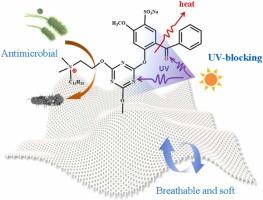Perdurable antimicrobial and ultraviolet-blocking cotton fabric by one-step eco-friendly strategy
IF 5.6
1区 农林科学
Q1 AGRICULTURAL ENGINEERING
引用次数: 0
Abstract
Cotton fabric (CF) is closely related to human life, while its inherent porous structure makes it unable to effectively shield the strong ultraviolet (UV) irradiation, and its superior hygroscopicity provides a favorable environment for microbes, resulting in microbes’ proliferation on CF. The UV irradiation and microbes’ proliferation affect the service life of CF and harm seriously human health. Therefore, developing antimicrobial and UV-blocking fabrics is for the well-being of human. Herein, a novel reactive monochlorotriazine terminated quaternary ammonium salt and benzophenone derivative (BCQ) was synthesized to covalently bind onto CF to fabricate an antimicrobial and UV-blocking CF without compromising its intrinsic physicochemical properties and biocompatibility. The antimicrobial rates of CF finished with 10.0 mg/mL BCQ were higher than 99.99 % against both E.coli and S.aureus, and its antimicrobial rates still were greater than 96 % even after 50 washes, while the cell survival rate was more than 99.5 %. Additionally, the UVA and UVB values were less than 0.5 %, and the UPF value CF finished with 50.0 mg/mL BCQ were up to 210.92. Therefore, we provide a strategy for developing an antimicrobial and UV-blocking CF.

一步到位的环保策略:耐用抗菌、阻挡紫外线的棉织物
棉织物(CF)与人类生活息息相关,但其固有的多孔结构使其无法有效屏蔽强烈的紫外线(UV)照射,而其优越的吸湿性又为微生物提供了有利环境,导致微生物在 CF 上大量繁殖。紫外线的照射和微生物的繁殖会影响 CF 的使用寿命,严重危害人体健康。因此,开发抗菌和阻隔紫外线的织物是为了人类的福祉。在此,我们合成了一种新型反应性单氯三嗪季铵盐和二苯甲酮衍生物(BCQ),将其共价结合到 CF 上,从而在不影响 CF 固有理化性质和生物相容性的前提下,制造出抗菌和阻隔紫外线的 CF。添加了 10.0 mg/mL BCQ 的 CF 对大肠杆菌和金黄色葡萄球菌的抗菌率均高于 99.99%,即使经过 50 次洗涤,其抗菌率仍大于 96%,而细胞存活率则超过 99.5%。此外,UVA 和 UVB 值均小于 0.5%,使用 50.0 mg/mL BCQ 后的 CF UPF 值高达 210.92。因此,我们为开发抗菌和阻隔紫外线的 CF 提供了一种策略。
本文章由计算机程序翻译,如有差异,请以英文原文为准。
求助全文
约1分钟内获得全文
求助全文
来源期刊

Industrial Crops and Products
农林科学-农业工程
CiteScore
9.50
自引率
8.50%
发文量
1518
审稿时长
43 days
期刊介绍:
Industrial Crops and Products is an International Journal publishing academic and industrial research on industrial (defined as non-food/non-feed) crops and products. Papers concern both crop-oriented and bio-based materials from crops-oriented research, and should be of interest to an international audience, hypothesis driven, and where comparisons are made statistics performed.
 求助内容:
求助内容: 应助结果提醒方式:
应助结果提醒方式:


